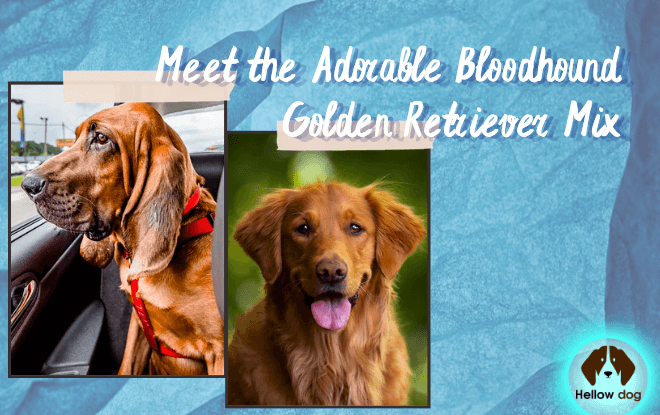Imagine a canine companion with the best of both worlds – the noble elegance of a Bloodhound and the heartwarming exuberance of a Golden Retriever. That’s the enchanting promise of the Bloodhound Golden Retriever Mix, a breed that embodies the magic of crossbreeding.
In a world where diversity reigns supreme, the art of combining two distinct breeds has never been more popular. As we delve into the world of the Golden Retriever Bloodhound Mix, we’ll uncover the secrets behind this captivating fusion and discover why it’s capturing the hearts of dog lovers worldwide.
Prepare to be charmed as we embark on an exciting journey into the world of this unique hybrid breed, where droopy ears meet wagging tails, and inquisitive noses lead us to adventures aplenty.
Popularity and curiosity surrounding mixed breed dogs
Mixed breed dogs have gained immense popularity due to their unique and unpredictable combination of traits. People are curious about them because they offer a blend of diverse qualities from different breeds, making each mixed breed dog a one-of-a-kind companion. This curiosity stems from the intrigue of not knowing exactly what to expect in terms of appearance, temperament, and behavior, which adds excitement to the process of adopting or owning a mixed breed dog. Additionally, many people are drawn to mixed breeds because of the potential health benefits associated with genetic diversity, as they may be less prone to breed-specific health issues. Overall, the popularity and curiosity surrounding mixed breed dogs are fueled by the desire for individuality, surprises, and the potential for healthier pets.
Origin and History
We will delve into the individual histories and origins of Bloodhounds and Golden Retrievers.
Bloodhound: A Noble History
The Bloodhound often referred to as the “Sleuth Hound” or “Chien de Saint-Hubert” in French, boasts a rich and noble history that dates back centuries. Its origins can be traced to ancient monastic communities in Belgium, where monks selectively bred dogs with exceptional scenting abilities.
Historical Significance
Bloodhounds were originally known as St. Hubert Hounds, named after Saint Hubert of Belgium, the patron saint of hunters. These dogs were highly prized for their remarkable tracking skills, making them invaluable companions for medieval hunters and nobility.
Evolution of the Breed
Over time, the breed evolved and was refined, with an emphasis on their keen sense of smell and tracking abilities. In the 19th century, British breeders played a significant role in shaping the modern Bloodhound, which was used for tracking criminals and lost persons.
Golden Retriever: A Scottish Treasure
The Golden Retriever, a beloved family dog and a popular choice for pet owners worldwide has its roots firmly planted in Scotland.
Historical Significance
The breed was developed during the mid-19th century in the Scottish Highlands. Sir Dudley Marjoribanks, later known as Lord Tweedmouth, is credited with the initial breeding experiments that led to the creation of the Golden Retriever.
Purposeful Breeding
Lord Tweedmouth aimed to produce a breed that excelled in retrieving game during hunting expeditions, particularly in the challenging Scottish terrain. He crossed a Yellow Retriever (now extinct) with the now-extinct Tweed Water Spaniel and later introduced bloodlines from Bloodhounds, Irish Setters, and more.
Emergence of the Modern Breed
The breed’s gentle temperament and exceptional retriever skills quickly endeared it to families and hunters alike. Golden Retrievers were officially recognized by the Kennel Club in the UK in 1903 and by the American Kennel Club (AKC) in 1925.
A Crossroads of History
The Bloodhound Golden Retriever Mix represents a fusion of these two distinct and storied breeds. It’s a testament to the art of purposeful crossbreeding, blending the tracking prowess of the Bloodhound with the amiability and retrieving instincts of the Golden Retriever. This unique hybrid breed brings together the best of both worlds, making it a fascinating subject of study for dog enthusiasts and prospective pet owners alike. In the following sections, we will explore the characteristics, temperament, and care requirements of the Golden Retriever Bloodhound Mix in more detail.
Physical Characteristics of the Bloodhound Golden Retriever Mix
Size and Build
The Bloodhound Golden Retriever Mix is a medium to a large-sized dog with a sturdy and well-proportioned build. They typically stand between 22 to 27 inches (56 to 69 cm) tall at the shoulder. In terms of weight, they usually range from 60 to 80 pounds (27 to 36 kg).
Coat Color and Texture
One of the most captivating aspects of this mix is its coat, which can vary widely in color and texture. The coat may exhibit shades of gold, red, black, or a combination of these colors. Their coat is typically dense, water-resistant, and can be either straight or wavy.
Facial Expressions
The Golden Retriever Bloodhound Mix has a friendly and expressive face that inherits endearing features from both parent breeds. Their eyes are soulful and often express intelligence and warmth. Ears can be medium to long in length, hanging down and framing the face.
Notable Features
What truly distinguishes this mix are its prominent, floppy ears that often resemble those of the Bloodhound parent. They may also inherit the loose, wrinkled skin and distinctive droopy eyes from the Bloodhound, giving them an endearing and somewhat comical appearance.
The tail is typically moderately long and can have a gentle curve, similar to that of the Golden Retriever. The Bloodhound Golden Retriever Mix’s physical characteristics blend the noble and regal appearance of the Golden Retriever with the unique and charming traits of the Bloodhound, resulting in a dog with a striking and lovable appearance. These distinctive features make them a favorite among dog enthusiasts and families seeking a visually appealing and friendly canine companion.
Temperament and Personality of the Bloodhound Golden Retriever Mix
The Bloodhound Golden Retriever Mix is known for its delightful blend of temperament and personality traits that make it an exceptional companion. Here, we’ll delve into the key characteristics that define this mixed breed:
- Intelligence
These dogs inherit intelligence from both parent breeds. Golden Retrievers are renowned for their smart and trainable nature, while Bloodhounds are valued for their superior scent-tracking abilities. The Golden Retriever Bloodhound Mix combines these attributes to create a dog that is quick to learn and eager to please.
- Loyalty
Loyalty is a hallmark trait of this mixed breed. They form deep bonds with their families and are often highly devoted to their owners. Their loyalty is coupled with an affectionate and loving nature, making them excellent companions for individuals and families alike.
- Friendliness
This mix is typically very sociable and friendly. They tend to get along well with people of all ages, including children and are often described as gentle giants. Their friendly disposition makes them excellent candidates for families seeking a loving and patient pet.
- Suitability as Family Pets
The Bloodhound Golden Retriever Mix excels as a family pet due to its friendly and patient nature. They are often great with children and other pets, making them a wonderful addition to multi-pet households.
Many owners of Golden Retriever Bloodhound Mixes share heartwarming anecdotes of their dogs going above and beyond to protect and comfort family members. These dogs are often described as emotionally attuned, sensing when their owners need support.
Owners often report that while their Golden Retriever Bloodhound Mixes may have a mischievous or playful side, they are also incredibly intuitive and sensitive, making them not just pets but cherished members of the family. Their unique blend of traits from two beloved breeds creates a dog that is both intelligent and endearing, making them an ideal choice for a wide range of families and individuals.
Care and Maintenance of the Bloodhound Golden Retriever Mix
Caring for a Bloodhound Golden Retriever Mix involves a combination of attention to their physical needs, grooming requirements, and creating a nurturing environment. Here are some essential tips to ensure their well-being:
- Grooming:
Brushing: Due to their often dense and medium to long coats, regular brushing is essential to prevent matting and reduce shedding. Brush at least a few times a week.
Bathing: Bathe them as needed, typically every 6-8 weeks or when they get dirty. Use a dog-specific shampoo to maintain the coat’s health.
Ear Cleaning: Since they may inherit floppy ears, clean their ears regularly to prevent infections.
Nail Trimming: Keep their nails trimmed to a comfortable length, as overly long nails can cause discomfort and affect their mobility.
- Exercise Needs:
Physical Activity: This mix is moderately active and benefits from daily exercise. Aim for at least 30-60 minutes of exercise, which can include walks, playtime in the yard, or trips to a dog park.
Mental Stimulation: Stimulate their minds with puzzle toys and interactive games to prevent boredom.
- Dietary Requirements:
Balanced Diet: Provide a well-balanced diet tailored to their age, size, and activity level. Consult with your veterinarian for specific dietary recommendations.
Fresh Water: Ensure they have access to fresh water at all times.
Meal Schedule: Establish a consistent feeding schedule to regulate their eating habits.
- Health Care:
Regular Vet Visits: Schedule regular check-ups with the veterinarian to monitor their overall health and address any potential health issues.
Vaccinations and Preventive Care: Keep up with vaccinations, flea and tick prevention, and heartworm medication as recommended by your vet.
- Creating a Healthy Environment:
Socialization: Socialize your Golden Retriever Bloodhound Mix from a young age to ensure they are comfortable around other dogs and people.
Training: Consistent and positive reinforcement-based training is crucial. They are intelligent and respond well to reward-based methods.
Safe Space: Create a safe and secure environment, as they may have a strong prey drive, particularly if the Bloodhound traits dominate.
- Emotional Well-being:
Affection: Shower them with love and attention. These dogs thrive on companionship and being part of the family.
Mental Stimulation: Engage their minds with puzzles, training, and interactive toys to prevent boredom.
By following these practical care tips, you can ensure that your Golden Retriever Bloodhound Mix enjoys a healthy, happy, and fulfilling life as a cherished member of your family.
Training and Socialization for the Bloodhound Golden Retriever Mix
Training and socialization are pivotal for the well-rounded development of a Bloodhound Golden Retriever Mix. Here’s why they are important and some tailored techniques:
Importance of Early Training and Socialization:
Behavioral Development: Early training helps shape their behavior and ensures they grow into well-mannered pets. Socialization ensures they are comfortable in various situations and with different people and animals.
Bonding: Training sessions provide an excellent opportunity for bonding between you and your dog, reinforcing trust and respect.
Safety: Proper training is crucial for their safety, especially since these dogs may have strong instincts like tracking (from the Bloodhound) or retrieving (from the Golden Retriever).
Training Techniques and Methods:
Positive Reinforcement: These dogs respond well to positive reinforcement techniques. Use treats, praise, and rewards to motivate and encourage desired behavior.
Consistency: Be consistent in your commands and expectations. Use the same cues for specific behaviors every time.
Basic Commands: Start with basic commands like sit, stay, and come. Once they’ve mastered these, move on to more advanced commands.
Socialization: Expose them to various people, pets, and environments from a young age. Gradually increase the level of challenge to build confidence.
Leash Training: Leash training is essential due to their potential to track scents. Teach loose-leash walking to prevent them from pulling excessively.
Potential Challenges and How to Address Them:
Scent Distraction: Due to their Bloodhound lineage, they may get easily distracted by scents during walks. Use high-value treats and practice recall in low-distraction environments before progressing to more challenging areas.
Stubbornness: They can be stubborn at times. Be patient and persistent, but avoid harsh training methods, as these can be counterproductive.
Separation Anxiety: These dogs are known for forming strong bonds with their owners. Gradually acclimate them to being alone for short periods to prevent separation anxiety.
Prey Drive: Some Bloodhound Golden Retriever Mixes may have a strong prey drive, so be cautious around small animals. Early socialization can help mitigate this instinct.
Consistency with Commands: Ensure that all family members use the same commands and techniques to avoid confusion.
Remember that every dog is unique, and their training needs may vary. Consider enrolling in a positive reinforcement-based obedience class, which can provide professional guidance and socialization opportunities. With patience, consistency, and early training efforts, your Golden Retriever Bloodhound Mix can become a well-behaved and well-adjusted companion.
Health and Common Issues of Bloodhound Golden Retriever Mixes
Bloodhound Golden Retriever Mixes are generally healthy dogs, but like all breeds, they can be prone to certain health issues. Being aware of these common problems and taking preventive measures can help maintain their well-being.
Common Health Issues:
Hip Dysplasia: Both Bloodhounds and Golden Retrievers are susceptible to hip dysplasia, which can be inherited by their mix. This condition affects the hip joint, causing pain and lameness. Regular exercise and maintaining a healthy weight can help reduce the risk.
Ear Infections: Due to their floppy ears, these dogs may be more prone to ear infections. Regular ear cleaning and routine vet check-ups can help prevent and detect ear issues early.
Bloat (Gastric Torsion): Large, deep-chested breeds like the Bloodhound can be at risk of bloat, a life-threatening condition where the stomach twists. Feeding smaller, frequent meals and avoiding strenuous activity after eating can reduce the risk.
Skin Allergies: Skin allergies and sensitivities can occur, leading to itching and skin problems. Regular grooming and a balanced diet can help manage these issues.
Eye Conditions: Both parent breeds may have genetic predispositions to certain eye conditions. Regular eye check-ups are essential to monitor and address any issues promptly.
Preventive Care Recommendations:
Regular Vet Check-ups: Schedule routine veterinary visits at least once a year to monitor your dog’s overall health and catch any potential issues early.
Vaccinations and Preventive Medications: Keep up with vaccinations, flea and tick prevention, and heartworm medication as recommended by your vet.
Dental Care: Dental health is crucial. Brush your dog’s teeth regularly and provide dental chews or toys to help keep their teeth clean.
Nutrition: Feed a high-quality, well-balanced diet appropriate for their age and activity level. Consult with your vet for dietary recommendations.
Exercise: Ensure they get regular exercise to maintain a healthy weight and promote overall fitness.
Environmental Safety: Create a safe environment, removing hazards that could harm your dog.
Spaying or Neutering: Discuss spaying or neutering with your vet to manage reproductive health and reduce the risk of certain cancers.
Maintaining Well-being:
Mental Stimulation: Keep their minds active with puzzle toys, training, and interactive games to prevent boredom and anxiety.
Emotional Well-being: Provide plenty of affection and social interaction. These dogs thrive on companionship and being part of the family.
Comfortable Living Space: Ensure they have a comfortable and safe living environment, with access to fresh water and shelter.
By being proactive with preventive care and addressing any health issues promptly, you can help your Bloodhound Golden Retriever Mix lead a happy, healthy, and fulfilling life. Regular communication with your veterinarian is key to maintaining their well-being and addressing any specific health concerns that may arise.
Adoption and Finding Breeders
Let’s provide guidance on adopting a Bloodhound Golden Retriever Mix and finding reputable breeders for those interested in purchasing a puppy while emphasizing responsible breeding and adoption.
Adoption:
- Research Rescue Organizations:
Start by researching rescue organizations that specialize in mixed-breed dogs, especially Golden Retriever Bloodhound Mixes. Look for local or national rescue groups.
- Visit Shelter Websites:
Check the websites of local animal shelters and rescue organizations. They often list available dogs along with their profiles.
- Attend Adoption Events:
Attend adoption events or visit rescue shelters in your area. This allows you to meet dogs in person and interact with them to find the right match.
- Ask Questions:
When you find a potential adoptee, ask the shelter or rescue organization staff about the dog’s history, health, temperament, and any known behavioral issues.
- Home Visit:
Be prepared for a home visit by the rescue organization. They want to ensure that your living situation is suitable for the dog’s needs.
- Consider Adoption Fees:
Be prepared to pay an adoption fee, which often covers vaccinations, spaying/neutering, and initial medical care.
- Patience is Key:
Be patient during the adoption process. Finding the right dog may take time, but it’s worth the wait.
Finding Reputable Breeders:
- Research Breeders:
If you prefer to purchase a puppy, research reputable breeders who specialize in Bloodhound Golden Retriever Mixes. Look for breeders with a good track record and positive reviews.
- Ask for References:
Ask the breeder for references from previous buyers. Speak to other owners to get insights into their experiences with the breeder and the dogs.
- Visit the Breeder’s Facility:
Arrange a visit to the breeder’s facility to meet the puppies’ parents and see the living conditions. Ensure it’s clean, and well-maintained, and the dogs are healthy and well-cared for.
- Health Testing:
Reputable breeders conduct health tests on their breeding dogs to screen for genetic conditions. Ask for health clearances and certification.
- Socialization and Training:
Inquire about the breeder’s socialization and training practices for the puppies. Well-raised puppies are more likely to become well-adjusted adults.
- Contract and Guarantees:
A responsible breeder will provide a written contract that includes health guarantees, return policies, and details on what they expect from puppy buyers.
- Avoid Puppy Mills:
Never buy a puppy from a puppy mill or pet store. These dogs often come from unhealthy and unethical breeding practices.
Emphasize Responsible Breeding and Adoption:
Stress the importance of responsible breeding and adoption to readers. Encourage them to adopt from rescue organizations or purchase from breeders who prioritize the health and well-being of their dogs.
Remind readers to consider the long-term commitment of dog ownership and to be prepared for the responsibilities that come with it.
Advocate for adopting mixed-breed dogs, as they often make wonderful companions and can be found in shelters and rescues waiting for loving homes.
Frequently Asked Questions (FAQs)
Frequently asked questions (FAQs) about the Bloodhound Golden Retriever Mix along with concise answers:
Q1: What is a Bloodhound Golden Retriever Mix?
A Bloodhound Golden Retriever Mix is a hybrid dog breed that results from crossing a Bloodhound with a Golden Retriever. It combines the traits and characteristics of both parent breeds.
Q2: What are the common physical traits of this mix?
Bloodhound Golden Retriever Mixes typically have a medium to large build, with a dense coat that can vary in color. They often inherit distinctive features like floppy ears and expressive eyes.
Q3: What is their temperament like?
These dogs are known for their intelligence, loyalty, and friendliness. They are often gentle, and affectionate, and make excellent family pets.
Q4: Do they require a lot of exercise?
Yes, they benefit from regular exercise, including daily walks and playtime. Mental stimulation is also essential to keep their intelligent minds engaged.
Q5: Are they good with children and other pets?
Yes, they are generally good with children and other pets due to their friendly and sociable nature. Early socialization is important to ensure positive interactions.
Q6: What are their grooming needs?
They require regular brushing to maintain their coat and prevent matting. Occasional baths, ear cleaning, and nail trimming are also part of their grooming routine.
Q7: Do they have any common health issues?
Common health concerns for this mix include hip dysplasia, ear infections (due to floppy ears), skin allergies, and bloat. Regular vet check-ups and preventive care are essential.
Q8: Are they easy to train?
Yes, they are intelligent and respond well to positive reinforcement training methods. Consistency and patience are key to successful training.
Q9: Where can I adopt a Bloodhound Golden Retriever Mix?
You can adopt one from local animal shelters, rescue organizations specializing in mixed-breed dogs, or by checking online adoption platforms.
Q10: How can I find a reputable breeder if I want a puppy?
Look for breeders with a good reputation, ask for references, visit their facility, and ensure they conduct health testing on their breeding dogs. Avoid purchasing from puppy mills or pet stores.
Q11: Are they good for first-time dog owners?
While they are generally friendly and trainable, they may require a bit more exercise and grooming than some other breeds. First-time owners should be prepared for their needs and invest in training and socialization.
Q12: How long do they typically live?
Bloodhound Golden Retriever Mixes have an average lifespan of 10 to 12 years with proper care and a healthy lifestyle.
Encourage readers to reach out with their own questions and remind them that every dog is unique, so it’s essential to consider individual temperament and needs when bringing a new canine companion into their lives.
Conclusion
In closing, the Bloodhound Golden Retriever Mix is truly a remarkable blend of traits, bringing together the noble tracking abilities of the Bloodhound with the loving and loyal nature of the Golden Retriever. Their distinctive appearance, coupled with their friendly temperament, makes them a captivating and cherished companion for families and individuals alike.
We invite readers to share their own experiences and stories with this exceptional breed. Whether you’re a proud owner or simply captivated by the Bloodhound Golden Retriever Mix, your stories can contribute to the ongoing appreciation of these wonderful dogs. Let’s celebrate their unique qualities and the joy they bring to our lives.







